GruffDraft: Being a man of many talents, do you paint regularly over time?
Bing Cariño: The Indigenous Madonnas series was an off-shoot of an earlier series of Madonnas with musical instruments, when Philippine supermall chain SM City brought to its Gensan branch the My City, My SM, My Art campaign, which brought me back to painting. My last series, I think, was in 2003. I put painting on hold as I became busy with dance theater.
Aside from Hans Brandeis, name other influences that have shaped your art, Indigenous Madonnas in particular.
Brandeis was very helpful... I was very careful with the representation because the concept was 'art exhibit with anthropological objects...' I look up to many artists as influence. I look at their works more with 'audience eyes' rather than as inspiration for my art-making. I particularly admire Frida Kahlo and Henri Rousseau because of their world view and how their art reflects the way they lived, Kahlo particularly. These two artists were self-taught like me. I also liked Rothko, Warhol, Basquiat, and the performance artist Marina Abramovic. In the Philippines I'm particularly into the life and works of Ossorio. Also, as a curator, I'm naturally interested in other artists' works.
Funding for the arts in General Santos pales in comparison to that of say, London and New York. If given the same resources, what do you think would be the immediate interventions to create and/or revive the arts in Gensan? Are any of these interventions also on the NCCA's agenda?
I believe that while these structures and institutions, including funding, are important in collating important works of art, what these institutions are after is to present and document works of established artists. The power structures in the arts serve artists who have made it, so to speak. Artists are left to their own devices. They should work for their art and their expressions. If given funding to bring local (Gensan) art somewhere, I'd use it for art education primarily. Education for both the artists who produce art, and their audience. The real struggle is actually finding an audience for these artists. I manage a small gallery here and I've realized it's not infrastructure that's the problem; it's the structure.
NCCA's agenda covers practically everything that concerns the development of Philippine arts and culture, but NCCA is not even a department so its reach is not as far and wide, unlike Tourism or Education that have regional offices. There are talks of creating a Department of Culture... Only when this is in place that arts and culture in the regions can prosper.
Back to your Indigenous Madonnas collection, which another writer indelicately compared to batik (a comparison I disagree with). Describe your painting style.
I found it funny that it's been compared to that. Batik, as a process, is different from my technique, and as product, it also looks different. After the writer told me that in person I made a mental note to ask why, but I didn't get the chance...
I basically came up with my own style so I don't use the influences in the manner of styling, but more on the "why pursue art" concept. My painting style actually comes as a response to how my medium works. I work with industrial enamel paints. Enamels are solvent-based paints and emit toxic fumes. Back in early 2000 when I did my first series, I came down with bronchopneumonia from prolonged exposure to the fumes. This, combined with the fact that enamels dry quickly, I learned a way of control for the material. Painting with enamels, you need to be working fast. There are drips all over. I learned to use the drips and splatters as part of the composition, part of the technique. It's not as conscious as Pollock doing drip paintings, but yes, dissecting my style and the way I do it, I find connection and definition with action painting. Still, action paintings are abstract; mine are representational. Shall I call it 'representational action painting' then?
More on Indigenous Madonnas. What is your motivation in dribbling/splattering paint on the faces of mother and child in each painting in the series?
For artists, the face is a convenient visual devise that tells emotions. I never learned to paint the face but I've never really obsessed over that. You're not the only one who was made curious by the splatters on the face. Again, they are consequences of the behavior of the medium. Earlier works have more 'organized' hair styles. The amount of tension these dripping and splattering on the faces have emotional qualities achieved in place of an anatomically correct facial expression rendering.
Being an actor, dancer, choreographer, cultural worker, curator, educator, interior designer, painter, researcher, teacher, theater director, and writer, what are your life goals personally and professionally? For your community?
I'm not really playing the hero doing all these except that I needed to break grounds so I can practice all these engagements. I was honed in University of the Philippines as an artist. When came back south there was nothing — no galleries, no theater — still, I wanted to continue doing what I was doing. So I established a theater group and an arts organization, and started building an arts community. That's when I became a cultural worker. All this because I wanted a platform to show my works. I worked with young artists at first because there were excess spaces in the opportunities that I've built for my craft. This also morphed into another realm that was curation — both material culture and performance curation. This happened when I started presenting works other than mine. It started as one-time projects until it became an entire advocacy for me. I suppose bigger aspirations stem out of small initiatives.
Do you have plans on bringing the Indigenous Madonnas collection elsewhere? More importantly, are you embarking on a new collection now or in the near future?
I'm working on 'a day in the life of a Maguindanao mother' series for I don't know what comes... Maybe an international show. I'm talking with some interested sectors in the States. Maybe that can be done if we pre-sell the works to help finance it. But I would want it in a nice, proper venue — not just a hotel lobby or a schoolhouse. I wanted to do an ethnographic exhibit also, bringing my collection of indigenous art to a museum there or something. I would like to bring any of my works there.
I normally create a series or collection of works first before thinking of what to do with them. Actually, that's how you work on a body of works — work as if that's the only thing that matters. What happens next is up to how and where life brings it to.
|
|
 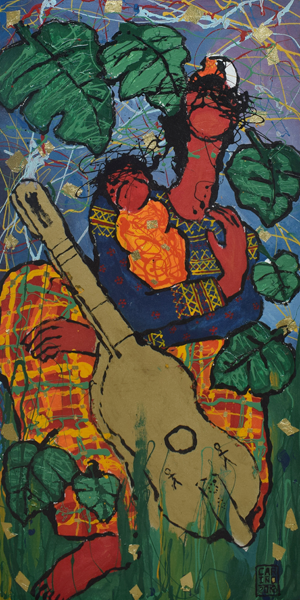
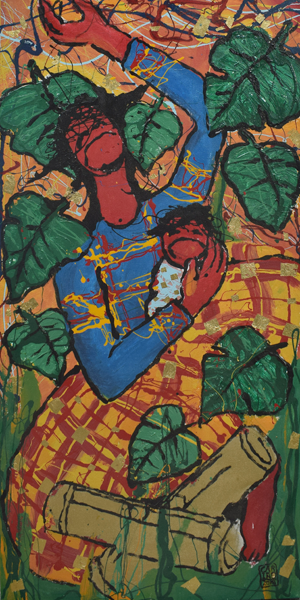 
The real struggle is actually finding an audience for... artists. I manage a small gallery... and I've realized it's not infrastructure that's the problem; it's the structure.
 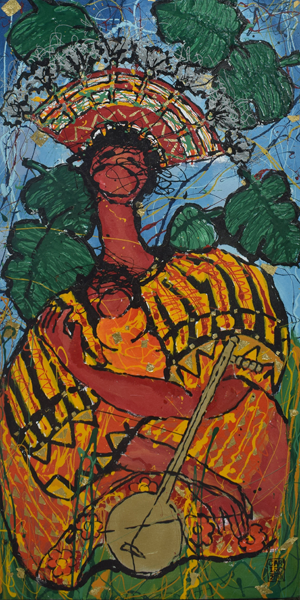
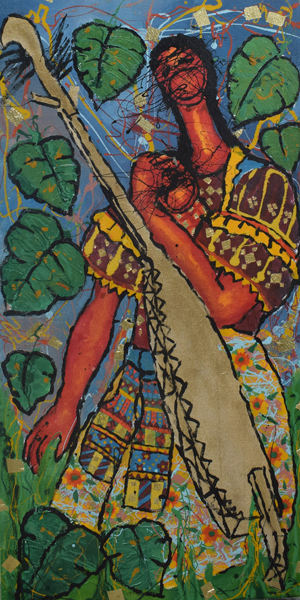 
...That's how you work... — work as if that's the only thing that matters. What happens next is up to how and where life brings it to.
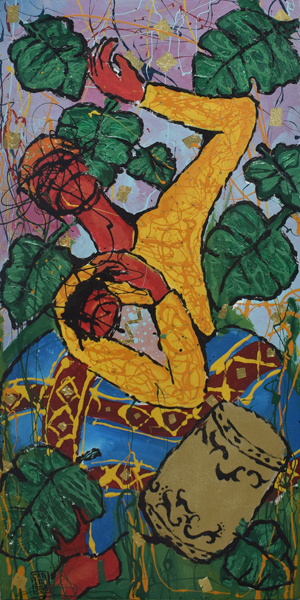 
 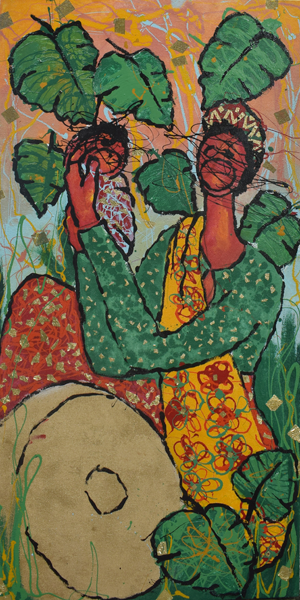
INDIGENOUS MADONNAS (2018) by Leonardo Salazar Cariño; 12 individual paintings in the series;
each painting 24" x 48" in dimensions; industrial enamel paint on canvas; brush/drip rendering of
indigenous mother-and-child images plus a traditional musical instrument in the foreground;
in the style of representational action painting (coined by the artist himself)
|

